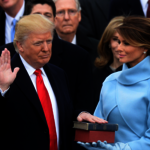A Fair Chance for All or a Washington Takeover? Education Policy and the Presidential Election 2016
The Atlantic Academy’s Road to the Elections No. 4
Matthias Enders, University Jena
About this Series
On November 8, nearly 200 Million registered voters are called upon to elect the next President of the United States of America, all 435 members of the House of Representatives as well as thirty-four of the one hundred senators. As in 2008, there is no incumbent, which is why both parties, the Democrats and the Republicans, will determine their candidates in primary elections. Thus, maybe fundamental changes but at least new accents in some policy fields should be expected.
With a monthly publication series, the Atlantic Academy will focus on this road to the elections in November. Political and economic scientists analyze policy fields as well as their roles in the (primary) elections and formulate expectations for a new presidency and Congress.
Alexis de Tocqueville's famous analysis of antebellum America as early as 1835 conveys one of the primary motives of American education policy when he remarks that every American possesses an equal amount of knowledge (Tocqueville 1835: 51). Equality in terms of accessibility of education was and is an important tool in ensuring upward social mobility. Within that context some groups - particularly Asian Americans - are portrayed as a model for all. The myth of them becoming widely successful because of their educational achievements forms a powerful narrative that is often used in political speeches. Because of this basic function as an enabler of individual success and social advancement (Busemeyer 2007: 73), as well as being a major ingredient in economic success stories (Schreiterer 2010: 481), education is one of the major policy arenas on all levels of American politics. Structurally however, it is fixed on the state and local levels, with only limited possibilities to be influenced by Congress or the White House. Still, the resulting tensions about responsibilities, contents, goals, and resources have always been central themes of presidential elections, with three problems being part of the 2016 campaign: the current student loan crisis, the general debate about the extent of the national government, and the fight about common standards.
Current education policy can be characterized as a replacement for social policy (Dobbins/Bieber 2016: 388). In order to achieve greater integration through education, primary and secondary educational institutions are not structured according to a model of vertical differentiation (Busemeyer 2007: 62). Separation of students does not take place during High School. Then, however, the American education system becomes highly segregated and receiving a good college education is becoming ever more expensive. Average tuition fees for four year programs at private, non-profit institutions (in 2015 dollars) rose from $10,000 in 1975 to almost $35,500 in 2015 (collegeboard.org 2016), which is even moderate compared to the cost of an Ivy League education. Traditionally, college education is seen as fundamental to a successful career and more than 40% of all Americans have attained a tertiary education (OECD 2014: 1). Many students pursue it even without the necessary funds available. To accommodate them, financial institutions offer student loan plans. Over the past decades the concurrent factors of a rising number of college students, rising tuition fees and a wage development that cannot keep up with fees has led to a student loan debt problem. Today, the average student loan borrower graduates with almost $29,000 in debt (ASA 2015: 8). Attributed to this are any number of negative effects, e. g. delayed investment in house ownership, starting a family later in life or simply struggling to buy daily necessities. Thus, the American higher education system is in danger of failing to meet the goal of furthering social security and upward mobility, also because the cost of attending a professional school (law, medicine, business etc.) after receiving a bachelor degree can increase student loan debts dramatically.
The traditionally contested issues in education policy have not vanished, though. They are rooted in a complex, multi-level structural set-up with the local basis for education policy never coming under any real threat from a Washington takeover. The 1965 Elementary and Secondary Education Act gave Congress some say in the financing of schools. It was a reaction to the legacy of racial segregation. Selecting a home and with it a school, too, was and still is significantly influenced by the factors race and income. The goal of the legislation was to create a level playing field. However, it also explicitly forbids the creation of a national curriculum. With the creation of the Department of Education (DoED) in 1979 this set-up was not altered significantly, since the Department serves more as an information platform than a powerful political actor (Dobbins/Bieber 2016: 389-390). Still, arguing for its abolishment is a common talking point among conservative politicians in their arguments on the supposedly bloated Federal Government. It is somewhat surprising that the DoED as a department of rather limited power is being used as a symbol for government overreach. Apparently, the cry for abolishing it is rooted in the century old tradition of education as an expression of local circumstances and values, but it can be described more accurately as part of the general conservative agenda of turning back or at least curtailing changes associated with the transformation of American society.
Like every other policy field in the US, education is embedded within a network of actors and institutions on various levels, each with different perspectives and goals. This plurality leads to a large number of influence vectors. As an example, conservative grass roots movements proved to be very successful in instituting their views on the local level. Stories about changing school curricula to incorporate creationist beliefs made news nationally and internationally. On the national level, lobbying on behalf of private and charter schools has increased significantly since the presidency of George W. Bush (OpenSecrets.org 2011) and since then, the role of the national government in setting education standards has been strongly contested. They were first introduced by the No Child Left Behind Act of 2001 (NCLB) in the form of standardized tests measuring educational achievements of schools. Not surprisingly, they were then immediately challenged by lobbyists and unions like the American Federation of Teachers. NCLB’s replacement, the Every Student Succeeds Act of 2015 (ESSA), continues those tests but modifies them somewhat taking regional differences into account when measuring achievements. That it took 14 years to replace NCLB, a law disliked by liberals and conservatives alike, illustrates the complex web of actors that regulate and influence education policy. In order to succeed, participants must seek alliances which usually leads to prolonged political fights, as demonstrated by another example, the Common Core State Standards Initiative (CCSSI). Being barred by law to create a national curriculum, both the White House and Congress are on the sidelines of this inter-state initiative to create comparable standards (Porter et. al. 2010: 103). Nevertheless, all Republican candidates quickly assured their voters how much they disliked it, even though 42 states, many conservative ones among them, and the District of Columbia have adopted CCSSI.
Education’s role in creating career opportunities remains undisputed. According to data from the Center for Household Financial Stability, education correlates positively with the net income of families. The higher the degree, the higher is the median income and any sort of degree gives people a better chance to earn higher wages (Boshara/Emmons/Noeth 2015: 4). As expected, this potential makes education a contested topic during political elections. However, because of the complex structural set-up of American education policy, it does not play a central role in most presidential campaigns. Since members of school boards are elected locally and since that is the most important vector of influence, it is in these elections, as well as campaigns for state legislatures and offices, that whole campaigns are centered around positions on education policy.
Both of the leading Republican candidates, Donald Trump and Ted Cruz, do not mention education explicitly in the positions sections of their campaign sites. And while Trump’s web site contains no reference to education at all (Trump 2016), it is mentioned on Cruz’s page only as an example of wasteful government spending, with the candidate promising to abolish the DoED as a part of his “Five for Freedom Plan” (Cruz 2016). This position is also articulated on the campaign trail, but not as an integral part of the candidate’s stump speeches. While Cruz asks his supporters to “imagine repealing every word of Common Core” (Washington Post 2015), notwithstanding that CCSSI is not a law and therefore cannot be repealed, Trump is also playing with the idea of abolishing the DoED (FoxNews Sunday, 18/10/2015). Contrary to Cruz, however, Trump’s message on the federal role in education is not completely negative. Though he does not offer any specific plans, he sometimes speaks about student loan debts on the campaign trail, having identified certain practices as malicious in his 2015 book “Crippled America”, and promises to act against them (Trump 2015: 59).
The two Democratic candidates, Hillary Clinton and Bernie Sanders, often cite education policy as an integral part of their plans to lift the American middle class out of its perceived economic misery. Promising to create funds to help public colleges to lower tuition, Clinton (2016a) is trying to catch up to Sanders, who identified student loan debts as a central campaign issue long before the former Secretary of State. Her opponent even argues for establishing a tuition free public college system, certainly one of the most radical campaign promises (aside from many of Trump’s positions) of the current political season. But he also offers less extreme measures, e. g. cutting interest rates on student loans and stopping a practice where the federal government actually makes profits on co-financing student loan plans, a position he shares with Trump (Sanders 2016). The essentially populist nature of both Trump’s and Sander’s campaigns makes such unlikely similarities possible. Clinton’s more centrist nature becomes visible not only in her more restrained approach to combating problems related to student loan debt. She is the only major candidate to actually offer positions on national education standards other than simply discrediting such efforts, for example by acknowledging the importance of educational standards throughout the US to create a fair chance for poor and minority children (Clinton 2016b).
While Republican positions on education center firmly on the question of the scope of the national government, Democrats still use the classic approach on education, namely identifying it as an important ingredient of equality, success, and participation. Of course, demographics are a big factor that can explain this divide, aside from obvious ideological differences. While Sanders profits enormously from the support of younger voters who often face large student loan debts, Trump and Cruz try to appeal to middle class Americans who generally favor less government and local solutions to social problems (Reeves 2015). But what is to expect from the next administration? The structural hurdles make it difficult for any administration to significantly alter the course of national education policy. Also, there is currently no legislative desire to change its path, as the bipartisan support for the ESSA demonstrates. The second current initiative, CCSSI, is completely out of the reach of the national government. Sander’s plan to make public colleges and universities tuition free faces unsurmountable legislative and financial obstacles. Therefore, the only significant change in national education policy would be the quasi abandonment of this field, as announced by Cruz and to a lesser extend Trump. However, history shows that giving up influence and power – however small it might be in the form of the DoED – is a very unlikely action for a government. Continuing the path of NCLB and ESSA is thus the most likely scenario for the new administration, whoever might lead it.
Bibliography
ASA (2015): Life Delayed. The Impact of Student Debt on Daily Lives of Young Americans, http://www.asa.org/site/assets/files/4743/life_delayed_whitepaper_2015.pdf.
Boshara, Ray/ Emmons, William R./Noeth, Brian J. (2015): The Demographics of Wealth. How Age, Education and Race Separate Thrivers from Strugglers in Today’s Economy, St. Louis (MO), https://www.stlouisfed.org/~/media/Files/PDFs/HFS/essays/HFS-Essay-2-2015-Education-and-Wealth.pdf.
Busemeyer, Marius R. (2007): Bildungspolitik in den USA. Eine historisch-institutionalistische Perspektive auf das Verhältnis von öffentlichen und privaten Bildungsinstitutionen, in: Zeitschrift für Sozialreform, 53:1, pp. 57-78.
Clinton, Hillary (2016a): The New College Compact. Costs won’t be a barrier, debt won’t hold you back, https://www.hillaryclinton.com/issues/college.
Clinton, Hillary (2016b): A world-class education for every child in every community, https://www.hillaryclinton.com/issues/k-12-education/.
collegeboard.org (2016): Trends in Higher Education, http://trends.collegeboard.org/college-pricing/figures-tables/tuition-and-fees-and-room-and-board-over-time-1975-76-2015-16-selected-years.
Cruz, Ted (2016): Rein in Washington, https://www.tedcruz.org/issues/rein-in-washington.
Dobbins, Michael/Bieber, Tonia: Bildungspolitik in den USA, in: Lammert, Christian/Siewert, Markus B./Vormann, Boris (Ed.): Handbuch Politik USA, Springer VS, Wiesbaden, pp. 381-402.
OECD (2014): Education at a Glance. Country Note USA, https://www.oecd.org/unitedstates/United%20States-EAG2014-Country-Note.pdf.
OpenSecrets.org (2011): Lobbyists Push Congress, Administration on No Child Left Behind, https://www.opensecrets.org/news/2011/07/no-child-left-behind-lobbyists/.
Porter, Andrew et al. (2010): Common Core Standards. The New U.S. Intended Curriculum, in: Educational Researcher, 40:3, pp. 103-116.
Reeves, Richard V. (2015): The dangerous separation of the American upper middle class, http://www.brookings.edu/blogs/social-mobility-memos/posts/2015/09/03-separation-upper-middle-class-reeves.
Sanders, Bernie (2016): It’s Time to Make College Tuition Free and Debt Free, https://berniesanders.com/issues/its-time-to-make-college-tuition-free-and-debt-free/.
Schreiterer, Ulrich (2010): USA, in: Simon, Dagmar/Knie, Andreas/Hornbostel, Stefan (Ed.): Handbuch Wissenschaftspolitik, Verlag für Sozialwissenschaften, Wiesbaden, pp. 481-493.
Tocqueville, Alexis de (1835 [2000]): Democracy in America, edited and translated by Harvey C. Mansfield and Delba Winthrop, Chicago University Press, Chicago (IL).
Trump, Donald J. (2015): Crippled America. How to Make America Great Again, Threshold Editions, New York (NY).
Trump, Donald J. (2016): On the Issues, https://www.donaldjtrump.com/positions.
Washington Post (2015): Transcript: Ted Cruz’s speech at Liberty University (March 23 2015), www.washingtonpost.com/politics/transcript-ted-cruzs-speech-at-liberty-university/2015/03/23/41c4011a-d168-11e4-a62f-ee745911a4ff_story.html.
About the Author
Since 2011, Matthias Enders works as a Research Assistant for the Chair of Political Theory and History of Ideas at the Friedrich Schiller University Jena. He has recently finished his PhD thesis about the ideological foundation of American science policy and currently works on a research project about the Vice Presidency in the United States.







